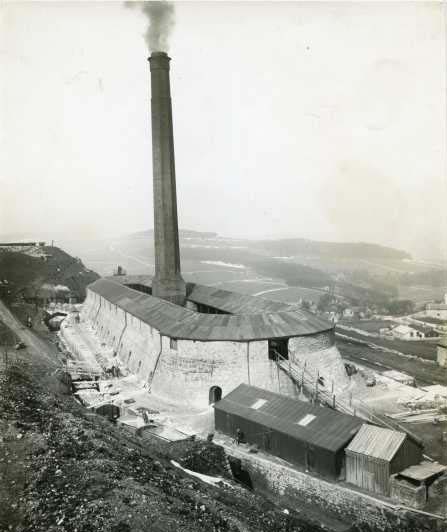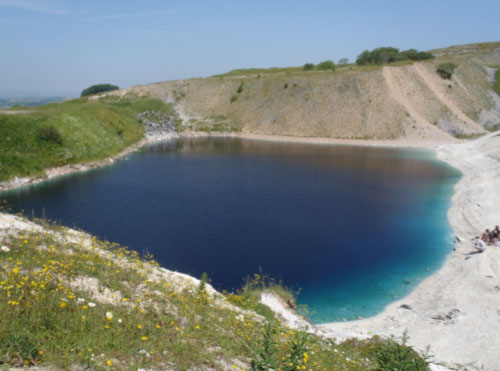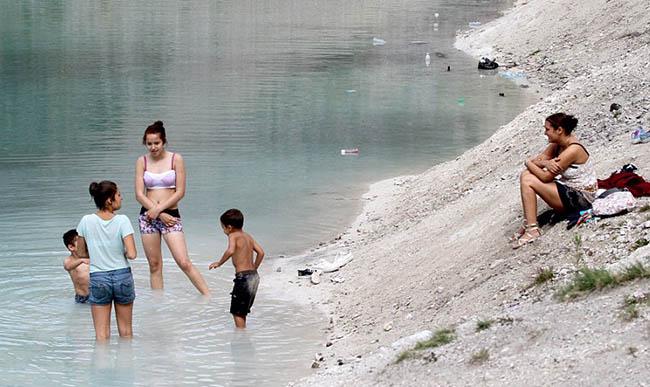Industrial History
Harpur Hill is a limestone hill, and both here and the adjacent Grin Low (or “Green Hill”) area to the north, have a long history of limestone quarrying and burning for the manufacture of quick lime. The earliest records of lime burning in the area date from the mid 1600’s at Grin Low Hill, about 0.5 km north of the Harpur Hill site. When Grin Low was purchased by the Third Earl of Devonshire in 1662, lime kilning was an extensive and well-established industry. It is likely that lime burning began much earlier than this but the number of kilns and lime production increased significantly during the late 17th and early 18th century to feed the growing demand for agricultural lime, particularly following the Enclosures Acts, for land improvement. Between the 17th and 19th century, over 130 lime kilns were producing over 120 horse loads of lime per day. By 1734 Grin Low lime production was at its peak. By 1819, lime kilning over much of the area had ceased, and the lime waste heaps on Grin Low were partially landscaped and replanted by the Duke of Devonshire’s Estate.

The Hoffman Kiln in operation at Harpur Hill
The first major kilns were built at Harpur Hill in 1835. Quarrying and the large-scale industrial production of lime at Harpur Hill increased from this time to feed growing industrial requirements for high purity lime. These early lime kilns were basic shaft kilns. However, from 1872, the Harpur Hill limeworks site subsequently utilised a multi-chambered Hoffman lime kiln, one of the largest of its type, which was in continuous operation until its closure in 1944. Examination of the historical Ordnance Survey maps show that, from 1883 to at least 1938, there appeared to be 12 shaft lime kilns (in addition to the Hoffman kiln) in operation at the Harpur Hill Lime Works. Lime burning at Harpur Hill ended in 1952. The Hoffman lime kiln itself was demolished in 1980 to make way for the development of a modern light industrial estate on the site, indeed, few complete Hoffman kilns now remain in the country.
So what's the problem?
Although at the time, the Hoffman Kiln was considered cutting edge, by modern standards it was an inefficient kilning process that produced large amounts of waste, and this waste containing a high concentration of residual lime (from overburnt and under-burnt limestone) and also ash, caused by the low quality local coal used in the process.
Rainwater and groundwater percolate through this waste and this forms a highly alkaline (pH >12) calcium hydroxide-dominated liquid, which travels through the spoil tip and emerges from its base into the Brook Bottom valley. Here, contact with carbon dioxide in the atmosphere and mixing with local bicarbonate water leads the development of an extensive area calcium carbonate deposits over a large area of the valley bottom downstream of the spoil tip.
Why a 'Blue Lagoon'?

The blue colour of the water is derived from the scattering of light by finely-dispersed calcium carbonate precipitated within the water column. The flooded base of the disused limestone quarry is surrounded by burnt lime waste spoil heaps on three sides (foreground, left and right on photo), and by limestone spoil (in the distant background of photo).
Because the water in the lagoon is largely undiluted by fresh water, it means here the water maintains a high pH (extremely alkaline). The lagoon has a pH of 11.3 - this is only just less than ammonia which is 11.5 and bleach’s pH which is 12.6. This could cause skin and eye irritations, stomach problems if swallowed, or fungal infections such as thrush.
Did you know - there's also a 'White Lagoon'...
Less famous is the white lagoon, closeby at Brook Valley bottom. It’s less well know as it’s located on farmland, not readily accessible by the public, and you can’t swim in it! It looks like a Turkish Salt Lake, but in fact, it’s a highly alkaline leachate (thick liquid). The chemistry involved with the white lagoon is extremely complex so there's no need to worry about it for the purpose of this earthcache, but I wanted to include a short section as it’s interesting to know the white lagoon has sat in the lower valley since 1945 and shows no signs of disappearing anytime soon.
Rainwater and groundwater passing through the lime waste tipped in Brook Bottom valley at Harpur Hill is wetting and leaching the lime, and probably also the calcium silicates associated with the lime clinker materials. This produces a highly alkaline calcium hydroxide dominated leachate (liquid) with a pH greater than 12. This discharges from the base of the spoil heaps in the bottom of the southern end of valley. Subsequent reaction of the calcium hydroxide leachate with atmospheric carbon dioxide results in the production of extensive calcium carbonates.

This has produced an extensive area of calcium carbonate and tufa deposits that extend for up to 2 km downstream of the lime waste spoil heaps! The deposits include calcite, aragonite and amorphous calcium carbonate and in addition, ikaite (calcium carbonate hexahydrate, CaCO3.6H2O) also forms on the site when temperatures fall below 8-10 °C during winter months - this mineral has previously only been described from Arctic and Antarctic climates and cold-climate alkaline lakes.
Solutions....?
Local residents made a case to the council due to the number of swimmers putting themselves at risk. The council erected signs warning of the high alkaline and it’s dangers, and also warning that the lagoon has been used as a tip and all kinds of old cars and rubbish, other chemicals and dead animals could be found in the lagoon.
Local residents were amazed that the signs were largely ignored and people continued to swim, including families bringing children and simply telling them not to put their head under or swallow the water.

Children watched by the relative who brought them, swim in the lagoon, with rubbish visible all around.
In 2012 the residents made a strong case to the council to fill in the lagoon but the water was deemed to dangerous to simply drain and they realised a flow of this water away from the site could be far more problematical. Instead, the council dyed the water black, and this did seem to put most people off swimming. Unfortunately, the strength of the processes at work here showed within a month the now natural colour returning. The council continued to dye the water over summer periods but during 2015 it seemed to remain blue, possibly due to budget cuts.
Logging Requirements (Questions to Answer)
Q1 – In your online log, please describe the colour of the lagoon today. If un-dyed, this may be blue, and if it is ‘blue’, please be a little more descriptive (as the amount and angle of the sun will affect how the calcium carbonate colours the lagoon). It could also be black if it’s been dyed recently, or somewhere in between if the dye is fading. As lagoon fights back, the original blue colour will be more prominent around the sides, so look closely.
Please e-mail me the answers to the remaining questions via my profile. I do read all answers and try to reply to them all; I may not reply immediately so please do not wait for a reply before posting your find. Ideally, please send your answers at the same time you submit your log, or within a few days of your visit. I do check answers have been sent for every log, if you do not send answers within a week your log may be deleted. You are not expected to have any previous geological knowledge, your best attempt at the answers is all that is required.
Q2 – The ‘beach’ surrounding the lake is a lovely white colour, it is the left over spoil after the lime has been extracted and contains calcium carbonate as described above. Please take a close look. Describe to me the exactly colour (pure white or not?), the texture, is it smooth, how big at the grains, that kind of thing. Take a walk down the lagoon edge, is it consistent? Note – the soil here will be highly alkaline, so you might want to poke with a stick or rock, you don’t need to use your hands.
Q3 – The Blue Lagoon is very scenic to see, and the quarry remains are now part of nature in this area. Given the extensive size of the whole site, do you think the current plan of erecting signs and occasionally dying the water is sufficient, or do you think more pro-active measures should be taken to preventing access?
Q4 - Calcium carbonate is a chemical compound, and is commonly found in rocks.
- Which rock type is particularly notable for containing calcium carbonate?
- Name a couple of examples of ‘natural’ things that calcium carbonate is the main component for.
- Name a couple of examples of things man uses calcium carbonate for.
You will need to briefly research online for these answers, but they should be very easy to find.
Optional Tasks
Q5 - Please include a photograph of yourself and / or GPSr with the Blue Lagoon, many people still like this evidence of their visit. Please feel free to include photos on your logs, although ideally, they should not give away the answers.
Q6 - This is a fun experiment for adults and children alike. I have made it optional as it involves planning ahead and making a purchase, and I don't want anyone visiting on a whim to be unable to log a find. However, I really hope many people will conduct the experiment as it will make your visit much more enjoyable and worthwhile.
I would like you to obtain a pH testing kit and bring it with you to the Blue Lagoon. Depending where you look the price may vary, but I was able to order one from a major online auction website for 24p, so it shouldn't break the bank. Also bring a bottle of tap water, perhaps around 500ml. Please include your results from this experiment in your online log, so everyone can see your findings.
pH kits are extremely simple to use. You simply dip the pH paper into the water and it changes colour to show you the pH content of the water, to the nearest pH. I firstly want you to dip the paper into the tap water or bottled water you have brought, and note the pH content. We would expect this to be fairly neutral (drinking water must have a pH value of 6.5-8.5 to fall within EPA standards, 7 being completely neutral). Note where the water came from along with your result in your online log.
Then please dip a piece of paper into the Blue Lagoon and make a note of it's pH. If there's been a huge amount of recent rain you might get a slightly different result to a period when there's been a long dry spell, because the input of natural water may weaken the effects of the lime waste. Please include the results of your tests in your online log, along with the conditions on the day and days preceding your experiment. This will allow us to see if there are any variations and possible causes. Be careful not to get the lagoon water on your hands during the experiment. If you do, please rinse it off with the rest of the bottled water - this was the other reason for bringing it!
Please enjoy your visit to the Blue Lagoon.